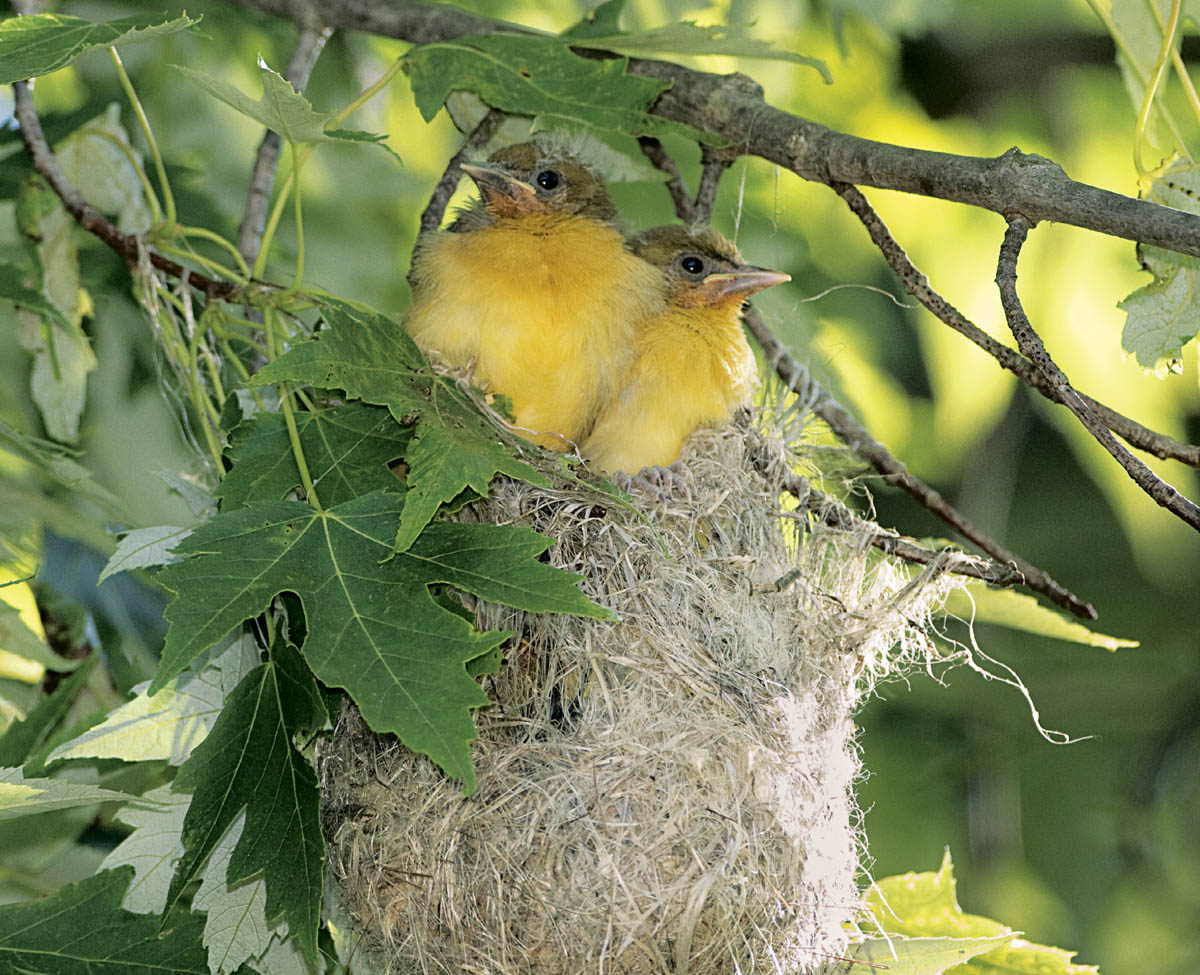
Baltimore Oriole nestlings
Before most female birds ovulate, they need a safe place to deposit and incubate their eggs until hatching. Depending on the species, nest-building can be the responsibility of the mother, both parents, or the father.

Baltimore Oriole nestlings
Some species make primitive nests, while others erect elaborate structures that can take weeks or months to complete. Some build no nest at all. A female Brown-headed Cowbird lays each of her many eggs in a different bird’s nest, but first she does her research. She studies all the birds in her area, choosing nests to parasitize with parents that are likely to warm and protect her eggs until hatching.

A female Eastern Bluebird brings pine needles to weave into the nest (inside the nestbox) while her mate looks on.

Killdeer lay and incubate eggs right out in the open.
The type of nest a bird constructs depends on many factors. Birds that produce precocial chicks often do not build as sturdy nests as birds producing altricial chicks (see box). Some species with precocial young, such as the Killdeer, make just a shallow scrape in sand, gravel, or dirt in which to lay the eggs. To protect against predators, they trust in the adults’ distraction displays and the eggs’ and adults’ cryptic coloration (coloring that conceals or disguises them).
The shape and strength of a bird’s bill and feet limit what kinds of materials it can gather and carry, and local habitats determine what nesting materials are available. In some species, birds produce some of their own nest materials, plucking loose belly feathers to line the nest.
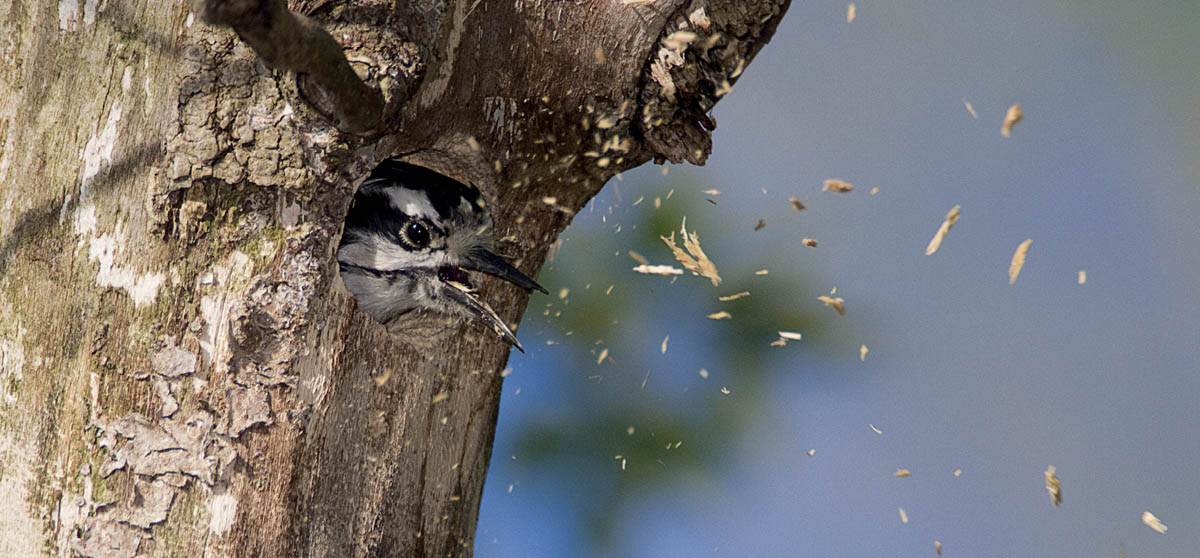
The hole this Downy Woodpecker excavates may later be adopted — and adapted — by a chickadee, bluebird, or swallow.
The tiny hummingbird female works with lightweight materials that she can easily maneuver and manipulate. The nest must be very tight to hold in her body heat, yet it has to expand to hold her two nestlings as they grow to her size before fledging. She binds thistle down with stretchy spider silk, inserting bits of lichen and moss for sturdiness and camouflage. The nest enlarges during chickhood from an incubator to a crib to a “big kid bed” and will not be reused (except occasionally as a support platform) for a new brood.
Many birds build a new nest each year, and, like hummingbirds, some even build new nests for each of two or three broods in a single season. Nests can become breeding grounds for parasites and germs, and materials can degenerate with weather and nestling activity.
Bald Eagles and Great Blue Herons, on the other hand, repair and rebuild year after year, so their stick nest grows larger and heavier with time. To make it last a lifetime, eagles choose long-lived, sturdy trees such as white pines when they start from scratch.
Most birds with precocial young nest on the ground, so the chicks can easily see and follow the parents. Wood Ducks, mergansers, and some other waterfowl nest in large cavities and nest boxes high in trees. The female often lines the floor with soft down feathers plucked from her belly and breast.
Woodpeckers excavate cavities for nesting, and also for nighttime roosting throughout the year. Chickadees may move into a birdhouse or small woodpecker cavity but often peck out their own cavity. That tiny chickadee bill packs a wallop!
Some birds that nest within cavities, such as all three North American bluebird species, do not have the physical adaptations for excavating. Bluebirds tend to choose unoccupied cavities, while House Sparrows and European Starlings often appropriate ones in use, destroying the nest, killing the young, and sometimes even attacking the adults. Unlike woodpeckers, most of these birds build a nest within the cavity.
Kestrels and screech-owls also nest in cavities or nest boxes, without adding nesting materials.
Birders often identify nests by the construction materials. Inside a birdhouse, a nest lined with feathers (from gulls, chickens, or other larger birds) points to Tree Swallows. One built with bits of trash likely belongs to House Sparrows. A nest with lots of green moss, located on or in a building, was almost definitely built by an Eastern Phoebe.
A combination of nest materials and egg color can help identify many nests, but the simplest way to identify a nest in use is to wait patiently for the parents to arrive.
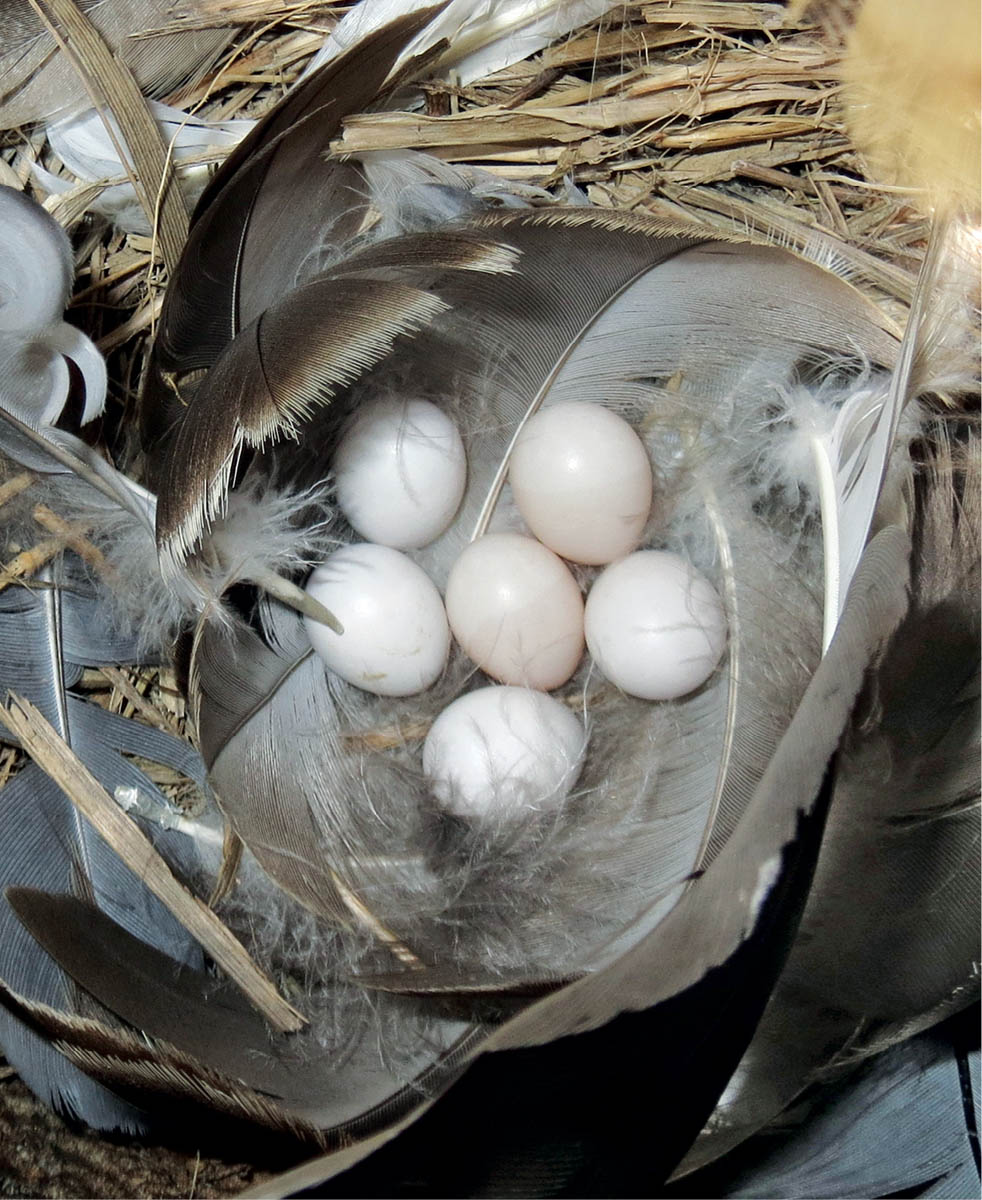
Eggs of a Tree Swallow
Most birds copulate (mate) frequently before and during egg production, but few do so conspicuously, since they would be vulnerable to predation when not on their guard. Some, such as Great Blue Herons, mate on the nest during nest construction, because nest-building stimulates hormonal levels. Some waterfowl mate on the water; Chimney Swifts, occasionally, in the air. Bald Eagles don’t mate during their dramatic midair courtship rituals (see here and here); actual copulation takes place on solid ground or a sturdy branch.
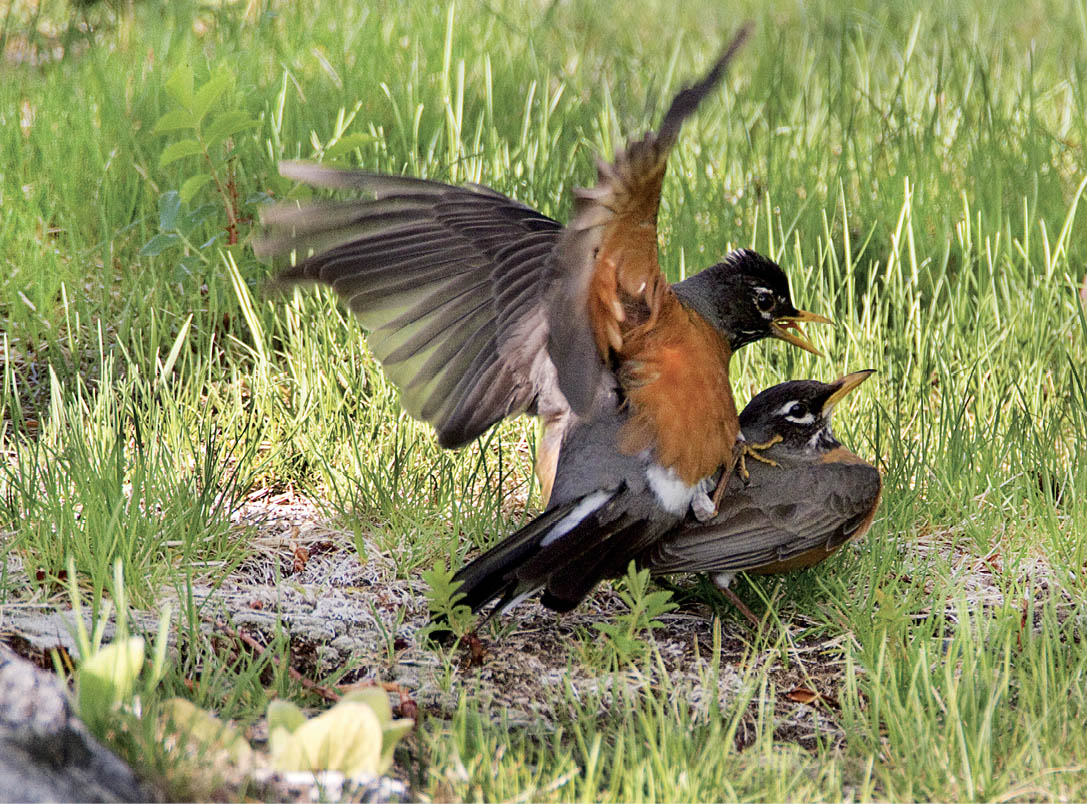
An American Robin pair copulates on the ground. Until the eggs are laid, the male stays close to the female and they copulate daily, often after the male’s dawn singing. He may first perform a strutting courtship display around the female on the ground, flicking his wings and tail.
How long birds incubate their eggs depends on many factors, including weather conditions, whether the species is precocial or altricial, and how much time the incubating parent must spend off the nest. Here are some typical lengths of incubation:
Trumpeter Swan: 32–37 days
Mallard: 23–30 days
Bald Eagle: 32–36 days
Killdeer: 22–28 days
Ruby-throated Hummingbird: 12–14 days
Pileated Woodpecker: 15–18 days
Black-capped Chickadee: 12–13 days
American Robin: 12–14 days
Yellow Warbler: 10–13 days
In the act of mating, the male sits on the female’s back, flapping his wings or gripping her feathers to keep his balance. She twists her tail upwards and he turns his tail toward hers so that their cloacas meet in what ornithologists romantically call the cloacal kiss. As that happens, millions of sperm enter her body and swim into the oviduct, working their way toward the ovary.
Sperm can survive in the oviduct for several days or even weeks. When one fertilizes an ovum, many of the remaining sperm may be pushed out by the descending egg, so birds tend to mate a few times a day while the female is producing eggs.
Many cavity nesters produce pure white eggs, which may help entering parents spot them in the darkness. Most other eggs are colored in ways that may hide them from potential predators.
Eggshell colors are usually produced by pigments secreted in the oviduct. These pigments, which may also strengthen the shell, usually come from the breakdown of normal body fluids such as bile and hemoglobin.
During the nesting season most females ovulate once every day or two and lay an egg 12 to 36 hours later, depending on the species. Ovulation ends when the female has laid an entire clutch, whose number of eggs also varies by species. Some species produce many more eggs in years when food is plentiful than when it’s scarce. Snowy Owls that lay only three or four eggs most years may produce up to eleven in a single clutch when food is abundant.
Females of some species are determinate layers: they’ll produce a certain number of eggs and stop. For example, Mourning Doves always lay two eggs. If one is removed, the female won’t replace it. Other species are indeterminate layers. The familiar barnyard chicken can produce eggs indefinitely if they’re consistently removed.
If eggs are not removed, a hen will stop laying after her clutch numbers about twelve and will grow broody, meaning she’ll start sitting on the eggs to incubate them. Many indeterminate layers with smaller broods (such as Northern Flickers) don’t start incubating until they’ve completed the clutch, and if eggs are removed, they will continue laying until the nest contains the right number.
Chicks don’t develop very much within an egg until their temperature reaches 98 to 100°F (37 to 38°C). Maintaining that steady temperature is the purpose of incubation. Many nesting birds develop a bare patch of skin on the belly, called the brood patch or incubation patch, so they can press hot skin directly against the eggs or young without feathers blocking body heat. Most birds’ internal temperature is above 100°F (38°C), usually from 104 to 108°F (40 to 42°C) and sometimes even higher.
Within the egg, tiny cells divide around a small part of the surface of the yolk. The developing embryo is soon visible as distinct from the yolk, but remains attached at the abdomen to the yolk sac, from which the chick obtains all its nourishment inside the egg. The yolk sac is usually absorbed into the body just before the chick hatches.
The on-duty parent turns each egg several times a day. This keeps the eggs uniformly warm and moist and prevents deformities caused by the embryo settling against and sticking to the membrane lining the inner shell.
Many hummingbirds, owls, and hawks start incubating when they lay the first egg. That egg hatches a day or two before the second, which hatches a day or two before the third, so the oldest chick has a significant head start. In many other species, incubation starts with the final or the penultimate (second to last) egg. Eggs in those clutches hatch out within hours of each other, so the nestlings remain the same size.
With hummingbirds, grouse, and many ducks, the female raises young without any help from the male after mating. Other birds divide responsibilities. Female robins build the nest (often using materials brought by the male) and incubate the eggs, but both parents feed and care for nestlings. The male robin takes primary responsibility for the fledglings as the female lays and then incubates the next clutch of eggs. Those eggs hatch just as the first fledglings have grown enough to go their own way, so the male can now help her raise the new brood.
See Part Two for details on how different bird species divide up parenting duties.
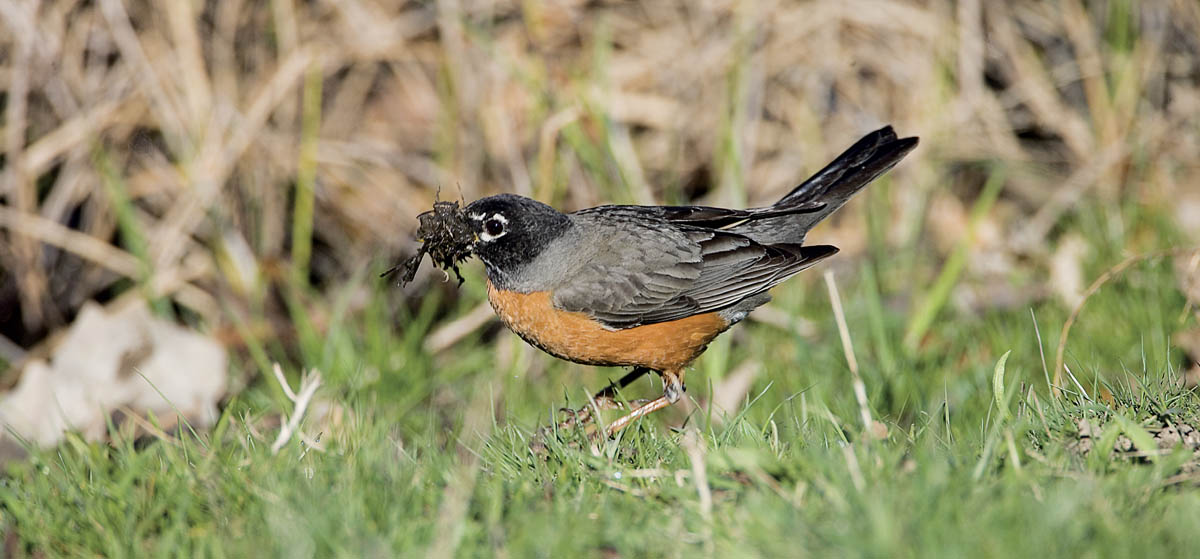
Some male American Robins help gather nesting materials, but the females do the actual building.
Within an egg, the growing chick’s body fits perfectly in the tight space between the shrinking yolk and the shrinking albumen. Depending on the length of the bill and legs, and the relative size of the body and head, chicks of different species fit in different ways. A Great Blue Heron chick’s head, for example, is bowed forward, and its bill, with a hard, rasp-like egg tooth on the tip, rests near its feet. Birds with shorter bills aren’t bent so dramatically.
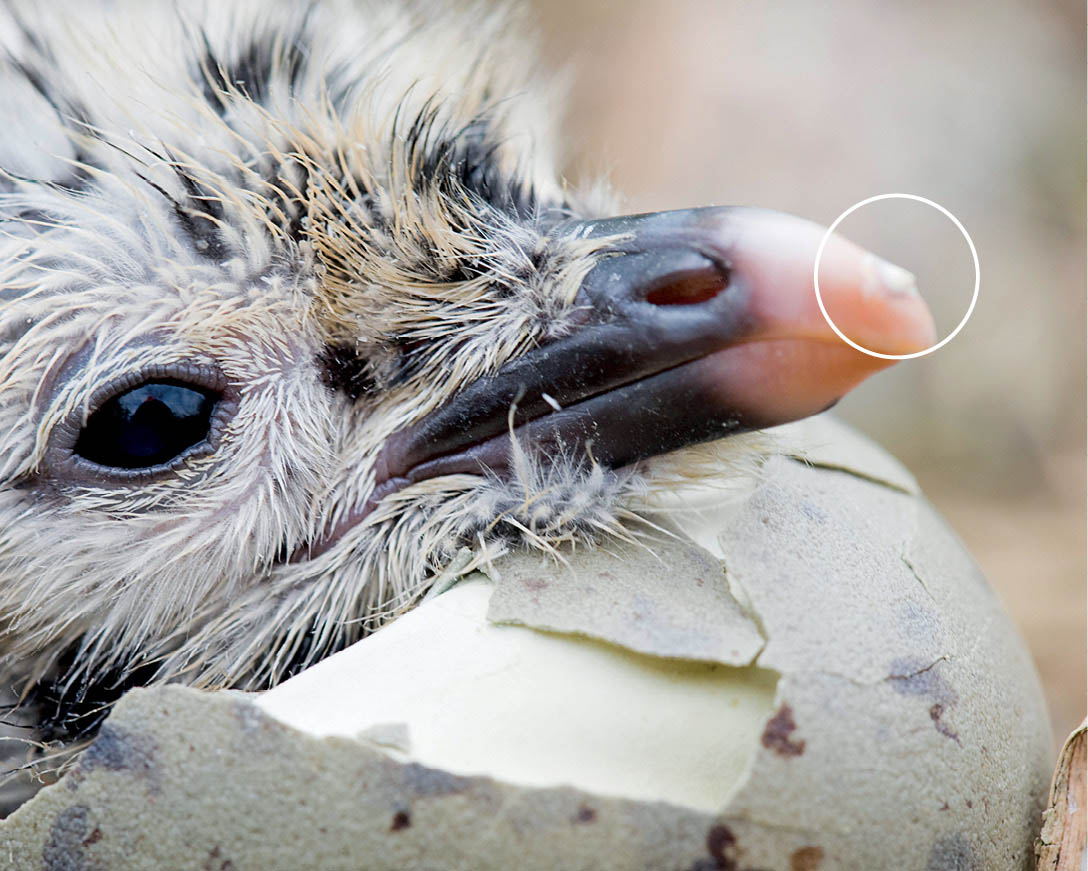
At the tip of the upper bill is the egg tooth — not a real tooth — which helped this hatchling gull break out of the egg. Within a few days, it is absorbed into the growing bill or it falls off.
As hatching nears, a chick scrapes its egg tooth against the inner shell until it finally pips, that is, pushes out a little hole. At this point, many species peep persistently while squirming to slowly expand that pip into a crack.
It may take more than 24 hours for the crack to grow large enough for hatching. Often in one final push, the little hatchling straightens out, separating the shell into two or more fragments. The next step is to shake off any bits of shell. Then the little bird may take a long nap as any downy feathers dry before mustering the energy to straighten out, or even to stand up, in the case of precocial chicks. Freedom at last!
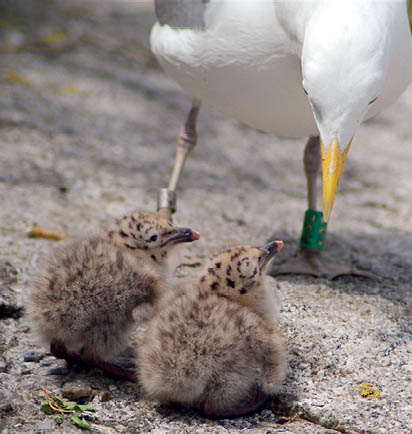
Precocial chicks, like these Herring Gulls, hatch with thick down and follow their parents away from the nest soon after hatching. They are referred to as chicks, rather than nestlings or fledglings.
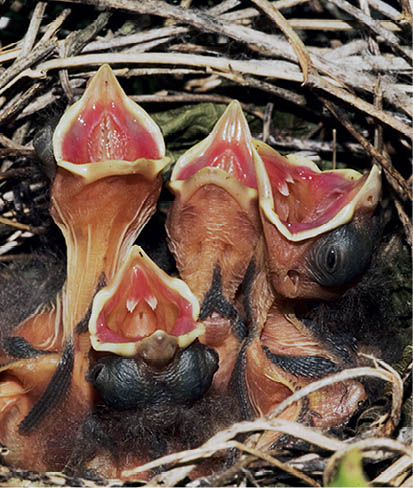
Altricial chicks, like these Northern Cardinals, hatch with sparse feathers and closed eyes, and cannot leave the nest for at least a week or two. They are called nestlings before they leave the nest, and then fledglings while they are still dependent on their parents.
Different species have different ways of feeding their young. The two basic strategies relate to how developed the young are when they hatch.
Altricial chicks hatch with virtually no feathers and their eyes sealed shut, capable only of raising their heads and opening their mouths for feedings. Woodpeckers are an extreme example. Their eggs are smaller than eggs of similarly sized birds, and the chicks hatch with no down whatsoever and are exceptionally tiny and undeveloped. The incubation time must be as short as possible because while the adult is sitting tight on the eggs, there’s very little air exchange deep inside the cavity and carbon dioxide levels are high. Once the eggs hatch, the frequent comings and goings of the parents feeding their young promote oxygen exchange.
Songbirds, herons, hawks, owls, hummingbirds, and parrots also produce altricial young. Altricial nestlings are most uncoordinated when they first hatch, capable of only one or two specific movements. When they feel something alight on the nest, or sense a shadow cast over them, they bounce up with their mouths agape. After they swallow, many altricial chicks immediately back up, often wagging their tail or making other obvious movements, and poop. Doing this so quickly after swallowing ensures that a parent will still be present to clean up the mess.
Most altricial chicks have brightly colored mouth-linings (often called the gape) and most parents have a powerful instinct to shove food into those bright mouths. What they feed the nestlings depends on the species.
Precocial birds must learn one thing while they’re still inside the nest — who their attending parent (usually their mother) is. As soon as they see and hear her, they imprint on her, and as soon as their down dries they follow her out into the big, wide world.
With every little waddling step they’re learning: how to negotiate rocks and pitfalls; how to pick out bits of food and ignore stones and other non-edibles; how to recognize danger; and how to respond to each threat, whether it’s hawks overhead, foxes creeping nearby, snakes, storms, wildfires, or thorns and barbed wire fences. Many baby birds succumb to such perils, but the ones that survive each encounter are more prepared for the next one.
Precocial chicks learn to socialize with others of their species, to interpret the different vocalizations and recognize sounds in their environment. They learn how to find the best places for eating, resting, hiding out, and bathing, and how to hunt for prey or locate other food sources.
Everything an altricial chick eats must be found and carried by its parents to the nest. The situation is quite different for birds with precocial young.
These chicks hatch already covered with thick down. They open their eyes within minutes and can walk fairly well within hours. Because they develop more fully inside the egg than altricial chicks do, incubation takes much longer than with similarly sized altricial species. The incubating parent(s) are often cryptically colored, trusting to camouflage for protection during the lengthy incubation.
When the chicks hatch, they imprint on a parent (usually their mother), memorizing her features, and follow her to food and safe resting places. Ducklings, grouse, chickens, and many other precocial chicks pick up food morsels on their own; in cranes, gulls, and some others, the adults search for the items and pass them to their chicks beak to beak.
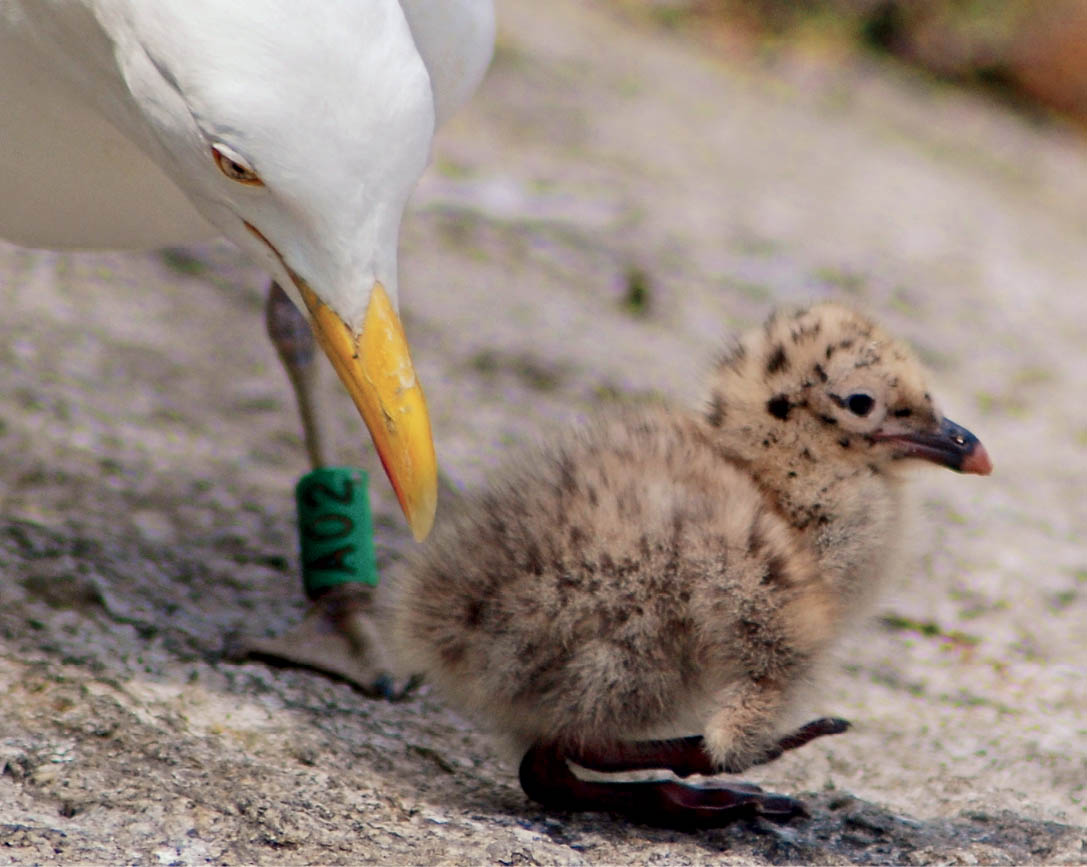
This 3-day-old semi-precocial Herring Gull chick is walking near the nest but still needs its parents to feed it.
Feeding behaviors vary widely even among species that feed their chicks the same thing. For example, Bald Eagles grab their fish in powerful, grasping talons, or feet. They can easily carry even large fish a few miles to their nest. When an eagle delivers a fish to the nest, it rips off chunks with its sharp, curved bill to feed the chicks.
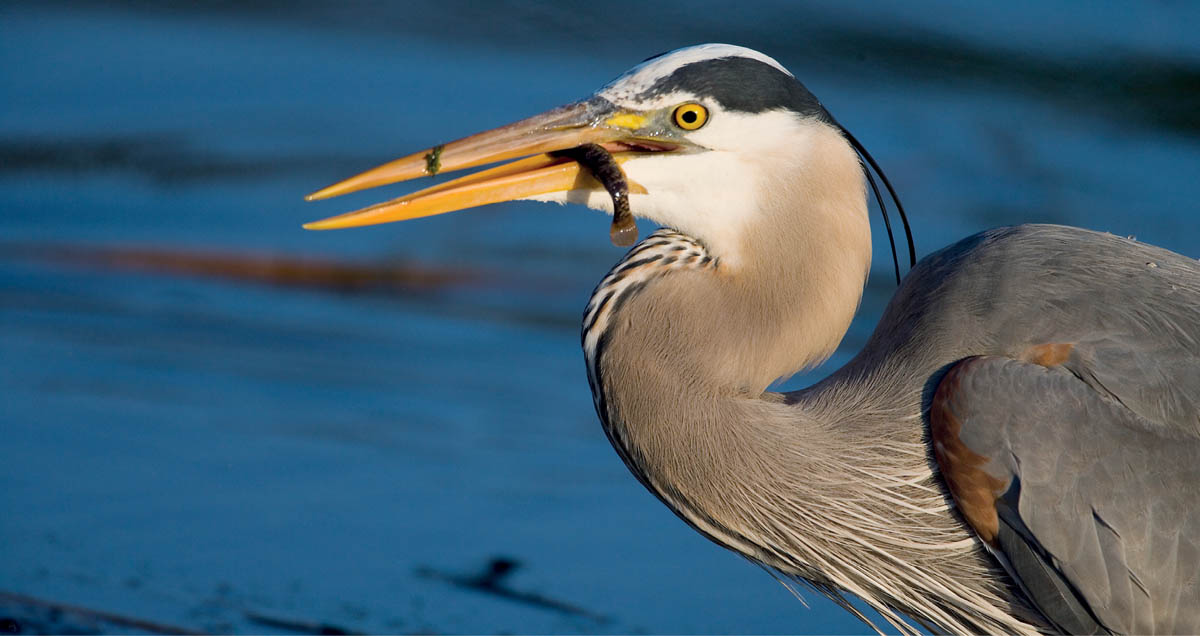
This adult Great Blue Heron just caught this fish. It will swallow it head first. When it’s caught a lot of fish, it will return to the nest to regurgitate the semi-digested fish to its young.
Herons cannot carry fish with their feet or bill. Instead, parents swallow as many fish as they can during a feeding bout, and then fly to the nest and regurgitate the catch. While nestlings are tiny, adults may hold the fish in their stomachs for up to a few hours before depositing them, so the meal will be like chunky baby food. Within a few days of hatching, the chicks start grabbing huge chunks, and the parents start regurgitating fish while they are still fresh and intact.
When people “rescue” a baby bird and try to raise it themselves, they’re making a tragic mistake. Parent birds give their young far more than food and protection from predators; they also provide an education. Baby birds, like children, go through critical stages of development, and suffer when deprived of the right kinds of stimulation at each stage. This is one of many reasons why it is illegal for unlicensed people to keep wild birds in the U.S. If you find a baby bird that is definitely orphaned or injured, you may be able to find a licensed rehabilitator via this website: www.owra.org/find-a-wildlife-rehabilitator.
Fledglings (and even some nestlings) of night-migrating species pay attention to the night sky. Over time they memorize star patterns and learn that one star remains fixed. Polaris, the North Star, defines north for them. We know this because scientists have raised birds in planetariums, experimentally rotating the stars around Betelgeuse instead of Polaris. These chicks oriented using Betelgeuse as “north.”
Many migrants also have tiny particles of magnetite in their brains, constituting an actual inner compass that comes in handy in clouds or fog. Their celestial navigation system, however, may be even more precise. People do no favors by “rescuing” baby migratory songbirds and keeping them indoors where they cannot absorb the lessons of the night sky. This is just one reason it’s so important to return baby birds to their nest or bring them to a licensed wildlife rehabilitator.
Unlike the adventurous precocial chicks, altricial birds spend their critical first weeks inside the nest. Even before opening their eyes, they absorb some of their species’ vocalizations and notice environmental sounds. After they open their eyes, they practice striking at and picking up objects. They study how the fibers composing their nest are woven together, and may start learning which environmental cues indicate danger. Once they leave the nest, virtually all altricial chicks remain with one or both parents for days or weeks (in some cases, months) as they hone other skills.
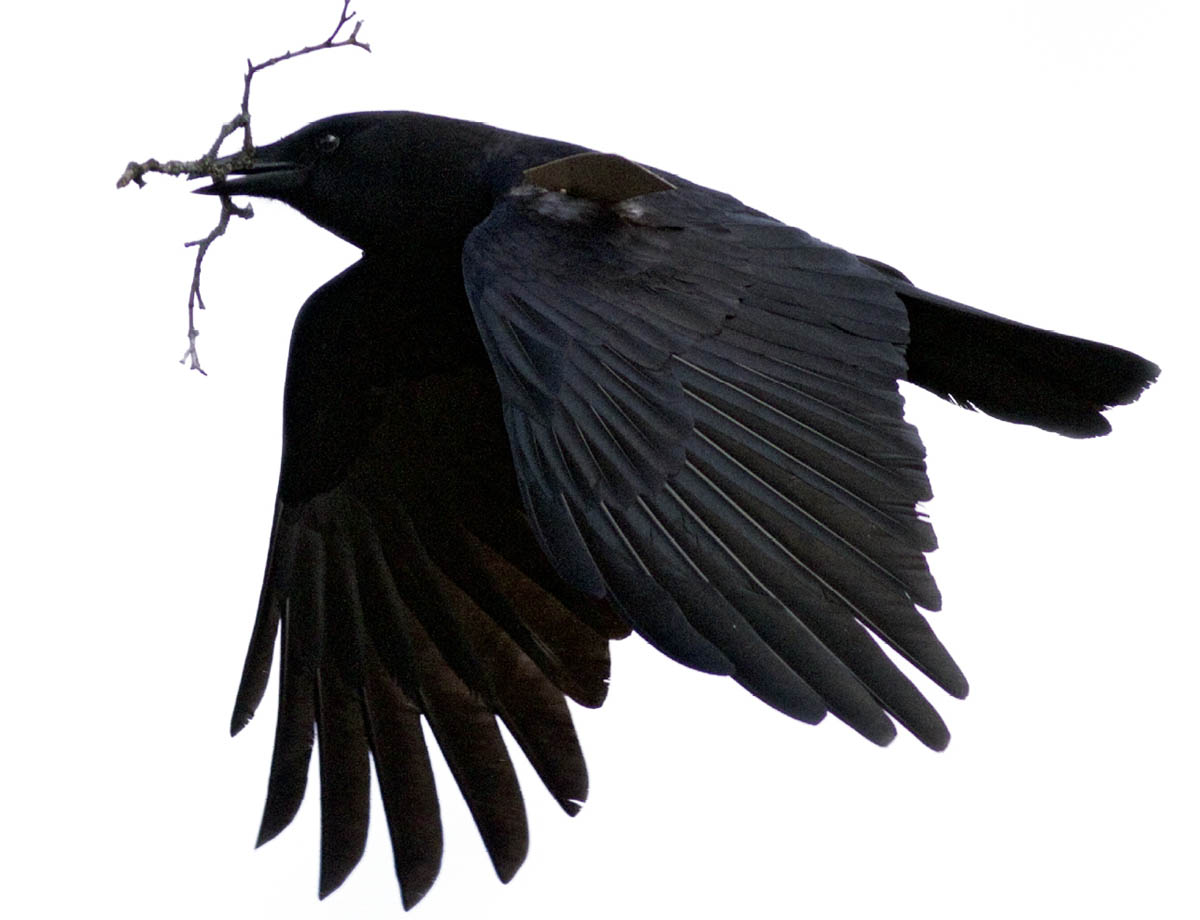
Young birds need varying degrees of instruction from their parents in how to survive on their own. Some, such as cranes, geese, and some swallows, migrate south with their parents and stay together the first winter. Others may separate just a day or two after fledging. Most young birds practice foraging for food for a while under their parents’ protection, but eventually the family scatters. For most species, the longer young birds remain with their parents, learning all their parents can show them, the more likely they are to survive.
In most altricial species, families break up a few weeks after the chicks fledge; in most precocial species, the chicks go their separate ways soon after they start flying. The vast majority of baby birds do not make it to their first birthday, but life expectancy rises dramatically for those that do make it to that benchmark. Survivors eventually start the entire cycle all over again. And so it goes.